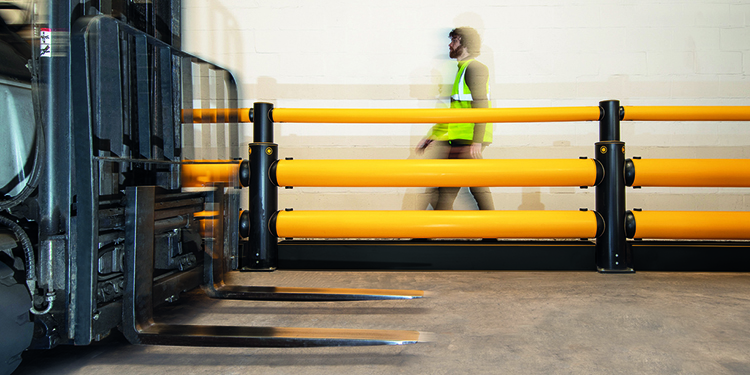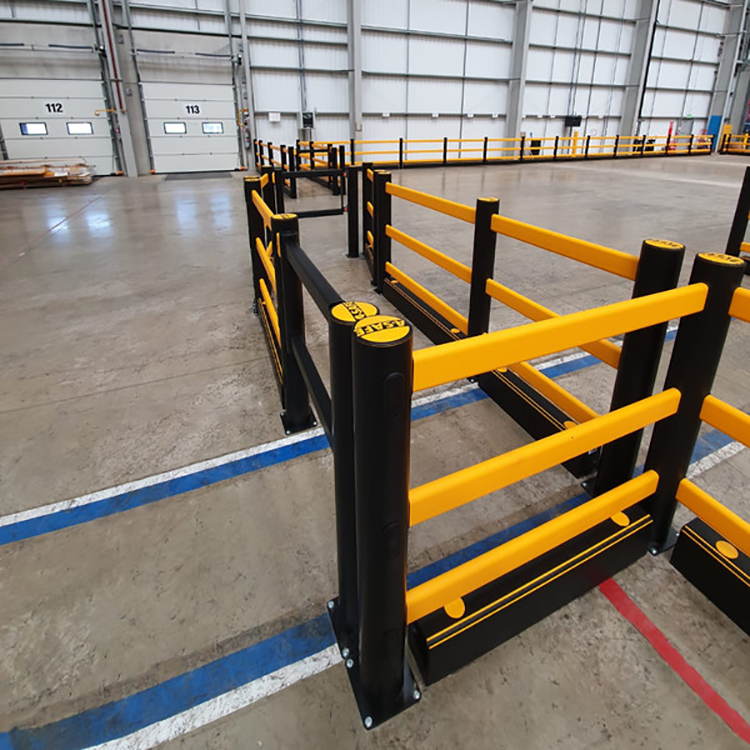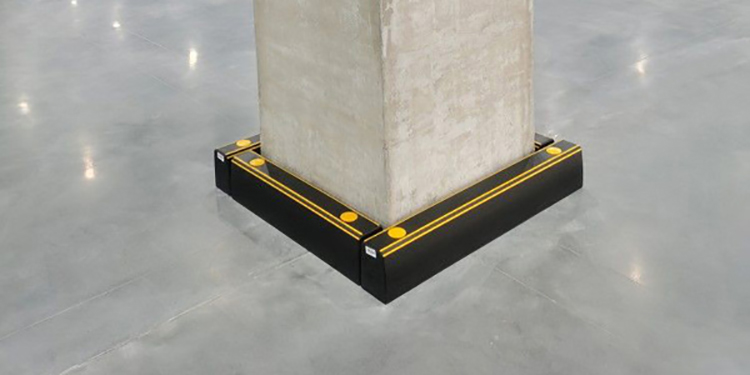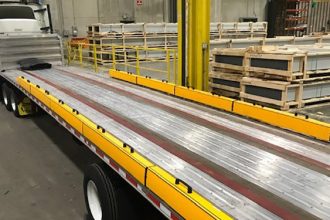Curb Barriers Guard Against Fork Penetration In Pedestrian, Equipment Areas

To protect personnel, equipment, and building structures from forklift impacts, many operations install safety barriers and other protective guarding devices. However, the majority of those solutions don’t extend all the way to the floor. Those gaps create the potential for the forks of a lift truck — loaded or unloaded — to pass under the protective barriers. This encroachment into restricted areas could cause injury to an associate, disable machinery, or damage facility components. To prevent these incidents, safety experts recommend floor-level installation of protective curb barriers to guard against fork penetration in pedestrian and equipment areas.
The Risks Posed by Lift Truck Forks
When driving through a facility, forklift operators usually raise the forks, whether they’re loaded or unloaded, up about three to four inches off the floor. This prevents the fork tips from grinding against the concrete and wearing down to a razor-sharp edge. It also gives the operator a more unobstructed view of their route.
“However, there’s still a risk that empty forks or those extending beyond the load can strike something. This happens when a forklift operator encroaches too close to a pedestrian walkway — even those shielded by protective barriers and guardrails,” said Paul Barlow, CEO of A-SAFE USA. A-SAFE is a member of the Protective Guarding Manufacturers Association (ProGMA).
Other areas vulnerable to fork penetration are building structures or assets. These include equipment, machinery, workstations, conveyor supports, walls, columns, or mezzanine pillars. Installing protective curb barriers around these areas provides protection against injury or damage, Barlow explained.
“Leveraging the expertise of a protective guarding vendor can help to identify the areas at greatest risk for a fork encroachment,” he said. “It’s a good idea to have them conduct a walkthrough assessment and make recommendations.”

How Protective Curb Barriers Work
To prevent fork encroachment, operations can install protective curb barriers. Also known as ground-level barriers and floor-level barriers, curb barriers typically consist of either steel or polymer materials. Anchored to the floor with specialized bolts, they come in a range of heights — usually between three to eight inches, noted Barlow.
“When a fork impacts the curb barrier, it disperses the force. While steel resists the impact, a barrier made from steel is frequently left deformed by the strike. Also, any energy not absorbed by the deformation transfers to the anchors and the floor,” he said. “Depending on the force of the impact, the anchors for this kind of curb may become dislodged. That allows the steel curb barrier to move out of position, and typically causes damage to the concrete floor as well.”
Polymer curb barriers deflect shallow angle or low-force impacts. In a direct strike, they absorb and dissipate the impact energy by flexing and then returning to their original shape. This spring effect reduces the chance of the anchors lifting out of the concrete floor. It also means polymer curb barriers are less likely to need replacement or repair after an impact, Barlow added.
Regardless of the type selected, curb barriers are usually colored safety yellow. On steel barriers, yellow paint is used; polymer barriers typically have yellow-colored material as part of their design.

Key Considerations When Selecting Curb Barriers
When specifying curb barriers for installation around pedestrian zones, equipment areas, or facility structures, there are a few key considerations.
- The type of vehicles used in the facility and their characteristics. This helps to determine the appropriate height of the curb barrier, said Barlow. “A 3- to 4-inch-tall barrier will stop a standard forklift. However, in an operation using larger equipment with bigger wheels or traveling with forks higher in the air will want to use a taller curb,” he advised.
- The maximum speed of the vehicles traveling in the area. “Different curb barriers have different impact ratings that indicate the maximum amount of force they can resist,” continued Barlow. “The faster the vehicle is traveling the more energy an impact will transfer into the protective curb. Areas where vehicles travel faster will require curb barriers with higher impact ratings.”
- The width of the protected area. Wider spaces will require the installation of multiple curbs together to create adequate coverage.
- The equipment or structures behind the curb barrier. “When placing protective barriers on the floor in front of other items, it’s important to leave space between the curb and the machinery or wall,” Barlow said. “There needs to be enough room to prevent any secondary contact from the curb as it deflects or deforms in reaction to the impact.”
- The existence of, or plan for, other protective guarding in the area. “Protective curb barriers can be installed as part of a complete guarding system, or as a retrofit after the fact,” he noted.
- Environmental conditions in the area. The materials used to construct the curb barrier may function differently in different environment. These include ambient temperature, cold storage, freezers, washdown areas, and other conditions. “The barrier supplier will likely have a solution that accommodates these environmental requirements,” said Barlow.
- Floor construction and condition. “The composition and condition of the floor will affect the type and number of anchor bolts used to secure the curb barrier in place,” he explained.
Learn More About Curb Barriers
Looking for more information about installing curb barriers and other protective guarding in your facility? The members of the Protective Guarding Manufacturers Association (ProGMA) are available for guidance and recommendations.



